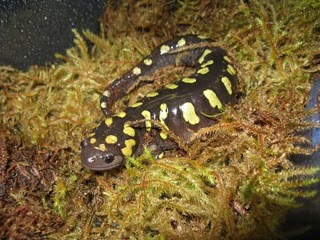 With a name like “Baby”, it is probably easy to assume that this spotted salamander is very young. On the contrary, he is 10 years old! That’s right, he actually came to the museum in 1998 as a baby, but old habits die hard in the animal department, so the name has stuck with him for his entire life.
With a name like “Baby”, it is probably easy to assume that this spotted salamander is very young. On the contrary, he is 10 years old! That’s right, he actually came to the museum in 1998 as a baby, but old habits die hard in the animal department, so the name has stuck with him for his entire life.
Baby is our only spotted salamander, while the rest are barred tiger salamanders. He is one of our many animals that live off-exhibit and are used for education purposes. Behind the scenes, he lives in a large plastic terrerium that has plenty of room for a water bowl and some hidey places, and also has a smaller second level that he can walk up to. In the wild, these salamanders spend much of their lives under logs or in burrows of other animals, and only come out at night to eat or during the breeding season. We try and mimick his wild living conditions by giving him moist coconut husk as his substrate, which is commonly used as reptile bedding for geckos, frogs and toads and has the same consistency as loose dirt. We also give him damp moss that he can hide under if he doesn’t want to bury himself or use his hidey places.
We use special filtered water for our salamanders and toads, because these animals are more sensitive to chemicals than other animals, including people. Thus, chemicals that are used to treat tap water, that we never think much of, can be harmful to them. It has been proven in the wild population that acid rains can prevent salamander eggs from developing properly and, thus, never hatch. A typical spotted salamander diet in the wild consists of worms, snails, spiders and virtually any insect they can catch. Our salamanders are fed crickets, but there is a chance in the future that their diets will broaden to include earthworms and snails.
Spotted salamanders are prevalent throughout parts of Canada and the United States, although there are other species of salamander that are threatened, endangered, or of special concern. Because of the diversity of terrain found in North Carolina, the state boasts around 50 different species of salamander, a number rivaling that of any place on Earth!
The information in this post, along with much more that you can learn, can be found at http://animals.nationalgeographic.com/animals/amphibians/spotted-salamander and http://en.wikipedia.org/wiki/Spotted_Salamander.
We are 2 very adventuresome Maltese dogs and we love learning about all critters, and we must say oh my! about this very colorful critter. Love, Your PaLs, LuLu and LoLLy! http://www.luluandlolly.com